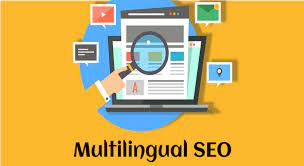
Mastering Multilingual SEO: A Guide to Global Online Success
The Power of Multilingual SEO: Reaching Global Audiences
In today’s interconnected world, businesses are expanding their reach beyond borders to tap into new markets and connect with diverse audiences. One powerful tool that can help businesses achieve this goal is multilingual SEO.
Search engine optimization (SEO) is crucial for improving a website’s visibility in search engine results. However, when targeting international audiences who speak different languages, traditional SEO strategies may not be sufficient. This is where multilingual SEO comes into play.
What is Multilingual SEO?
Multilingual SEO involves optimizing a website to rank well in multiple languages and countries. By creating content in different languages and implementing language-specific keywords and meta tags, businesses can attract organic traffic from global audiences searching in their native languages.
The Benefits of Multilingual SEO
- Expanded Reach: By optimizing your website for multiple languages, you can reach a wider audience and increase your global presence.
- Improved User Experience: Providing content in users’ preferred languages enhances their experience and encourages engagement.
- Higher Conversion Rates: When users find content in their native language, they are more likely to trust the information and take desired actions.
- Competitive Advantage: Investing in multilingual SEO can give you a competitive edge in global markets by outranking competitors who only target one language.
Tips for Implementing Multilingual SEO
- Keyword Research: Conduct keyword research for each target language to identify relevant terms and phrases used by local audiences.
- Cultural Considerations: Understand cultural nuances and preferences to create content that resonates with each target audience.
- Hreflang Tags: Implement hreflang tags to indicate to search engines which language versions of a page are available for indexing.
- Localized Content: Create high-quality, localized content that addresses the specific needs and interests of each target market.
- Monitor Performance: Track the performance of your multilingual SEO efforts using analytics tools to make data-driven optimizations.
In conclusion, multilingual SEO is a powerful strategy for businesses looking to expand their reach globally and connect with diverse audiences. By investing in multilingual optimization techniques, businesses can unlock new opportunities, drive organic traffic, and achieve sustainable growth in international markets.
Top 5 Frequently Asked Questions About Multilingual SEO
- What is multilingual SEO and why is it important?
- How does multilingual SEO differ from traditional SEO?
- What are the benefits of implementing multilingual SEO for a website?
- What are some best practices for optimizing a website for multiple languages?
- How can businesses measure the success of their multilingual SEO efforts?
What is multilingual SEO and why is it important?
Multilingual SEO refers to the practice of optimizing a website to rank well in multiple languages and regions, allowing businesses to reach a diverse global audience effectively. It involves creating content in different languages, using language-specific keywords, and implementing strategies to improve visibility in search engine results across various linguistic demographics. Multilingual SEO is crucial for businesses seeking to expand their online presence beyond borders as it enables them to connect with international audiences in their native languages. By investing in multilingual SEO, businesses can enhance user experience, increase organic traffic, build trust with global consumers, and gain a competitive edge in the global marketplace.
How does multilingual SEO differ from traditional SEO?
Multilingual SEO differs from traditional SEO in that it focuses on optimizing a website to rank well in multiple languages and countries, catering to diverse global audiences. While traditional SEO primarily targets a single language or region, multilingual SEO involves creating content in different languages, implementing language-specific keywords and meta tags, and considering cultural nuances to enhance user experience and engagement. By incorporating multilingual optimization techniques, businesses can expand their reach, improve visibility in international markets, and connect with users searching in their native languages, ultimately driving organic traffic and achieving greater success on a global scale.
What are the benefits of implementing multilingual SEO for a website?
Implementing multilingual SEO for a website offers a range of benefits that can significantly enhance its online presence and performance. By optimizing a website for multiple languages, businesses can expand their reach to global audiences, improve user experience by providing content in users’ preferred languages, increase conversion rates as users are more likely to engage with content in their native language, and gain a competitive advantage in international markets by outranking competitors who only target one language. Overall, multilingual SEO enables businesses to tap into new markets, connect with diverse audiences, and drive sustained growth in the digital landscape.
What are some best practices for optimizing a website for multiple languages?
When optimizing a website for multiple languages, it is essential to follow some best practices to ensure maximum effectiveness. Some key strategies include conducting thorough keyword research in each target language, understanding cultural nuances and preferences to create relevant content, implementing hreflang tags to indicate language variations to search engines, creating high-quality localized content tailored to each audience, and regularly monitoring performance metrics to make data-driven optimizations. By adhering to these best practices, businesses can enhance their global visibility, engage diverse audiences effectively, and drive sustainable growth in international markets through multilingual SEO efforts.
How can businesses measure the success of their multilingual SEO efforts?
Measuring the success of multilingual SEO efforts is essential for businesses to evaluate the effectiveness of their strategies and optimize their performance. One common approach is to track key performance indicators (KPIs) such as organic traffic, keyword rankings in different languages, conversion rates from international visitors, and engagement metrics like bounce rate and time on page. Additionally, businesses can use tools like Google Analytics to monitor the performance of each language version of their website, identify trends, and make data-driven decisions to improve their multilingual SEO campaigns. Regularly analyzing these metrics and adjusting strategies accordingly can help businesses gauge the impact of their efforts and maximize their online visibility across global markets.